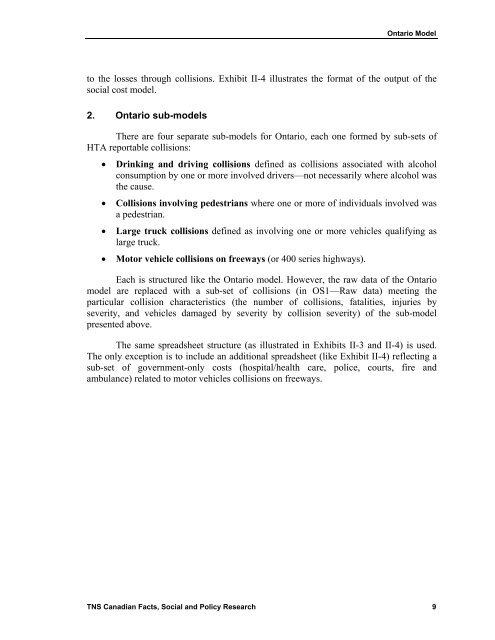- Page 1 and 2: TP 14800F Analysis and Estimation o
- Page 3 and 4: APPENDIX A: DETAIL ON CALCULATIONS
- Page 5 and 6: • Large truck. Collisions involvi
- Page 8: ABBREVIATIONS CAC Criteria Air Cont
- Page 11 and 12: Analysis and Estimation of the Soci
- Page 13 and 14: Analysis and Estimation of the Soci
- Page 15 and 16: Analysis and Estimation of the Soci
- Page 17: Analysis and Estimation of the Soci
- Page 22 and 23: III ONTARIO MODEL This chapter desc
- Page 24 and 25: Ontario Model redistribution. Simil
- Page 26 and 27: Ontario Model • Pedestrian Injure
- Page 28 and 29: Ontario Model Based on this analysi
- Page 30 and 31: Ontario Model Step 3 Allocate addit
- Page 32 and 33: Ontario Model damaged based on this
- Page 34 and 35: Ontario Model 1. Number of total an
- Page 36 and 37: Ontario Model 2.99; specialist—1.
- Page 38 and 39: Ontario Model 5. Tow trucks Tow tru
- Page 40 and 41: Ontario Model Exhibit III-5 Core WT
- Page 42 and 43: Ontario Model We combine this value
- Page 44 and 45: Ontario Model 6. Ambulance The Onta
- Page 46 and 47: Ontario Model individuals who self-
- Page 48 and 49: Ontario Model threatening injury, p
- Page 50 and 51: Ontario Model d) Additional Polluti
- Page 52 and 53: Ontario Model VARIABLE DATA LOST TI
- Page 54: Ontario Model We have no data to gu
- Page 57 and 58: Analysis and Estimation of the Soci
- Page 59 and 60: Analysis and Estimation of the Soci
- Page 61 and 62: Analysis and Estimation of the Soci
- Page 64 and 65: V ONTARIO SUB-MODELS AND THEIR SOCI
- Page 66 and 67: Ontario Sub-Models and Their Social
- Page 68 and 69:
Ontario Sub-Models and Their Social
- Page 70 and 71:
Ontario Sub-Models and Their Social
- Page 72 and 73:
Ontario Sub-Models and Their Social
- Page 74 and 75:
Ontario Sub-Models and Their Social
- Page 76:
Ontario Sub-Models and Their Social
- Page 79 and 80:
Analysis and Estimation of the Soci
- Page 81 and 82:
Analysis and Estimation of the Soci
- Page 83 and 84:
Analysis and Estimation of the Soci
- Page 85 and 86:
Analysis and Estimation of the Soci
- Page 87 and 88:
Analysis and Estimation of the Soci
- Page 89 and 90:
Analysis and Estimation of the Soci
- Page 91 and 92:
Analysis and Estimation of the Soci
- Page 93 and 94:
Analysis and Estimation of the Soci
- Page 95 and 96:
Analysis and Estimation of the Soci
- Page 97 and 98:
Analysis and Estimation of the Soci
- Page 99 and 100:
Analysis and Estimation of the Soci
- Page 101 and 102:
Analysis and Estimation of the Soci
- Page 103 and 104:
Analysis and Estimation of the Soci
- Page 105 and 106:
Analysis and Estimation of the Soci
- Page 107 and 108:
Analysis and Estimation of the Soci
- Page 109 and 110:
Analysis and Estimation of the Soci
- Page 111 and 112:
Analysis and Estimation of the Soci
- Page 113 and 114:
Analysis and Estimation of the Soci
- Page 115 and 116:
Analysis and Estimation of the Soci
- Page 117 and 118:
Analysis and Estimation of the Soci
- Page 120:
Appendix A Detail on Calculations o
- Page 123 and 124:
Analysis and Estimation of the Soci
- Page 125 and 126:
Analysis and Estimation of the Soci
- Page 127 and 128:
Analysis and Estimation of the Soci
- Page 129 and 130:
Analysis and Estimation of the Soci
- Page 131 and 132:
Analysis and Estimation of the Soci
- Page 133 and 134:
Analysis and Estimation of the Soci
- Page 135 and 136:
Analysis and Estimation of the Soci
- Page 137 and 138:
Analysis and Estimation of the Soci
- Page 139 and 140:
Analysis and Estimation of the Soci
- Page 141 and 142:
Analysis and Estimation of the Soci
- Page 143 and 144:
Analysis and Estimation of the Soci
- Page 145 and 146:
Analysis and Estimation of the Soci
- Page 147 and 148:
Analysis and Estimation of the Soci
- Page 149 and 150:
Analysis and Estimation of the Soci
- Page 151 and 152:
Analysis and Estimation of the Soci
- Page 153 and 154:
Analysis and Estimation of the Soci
- Page 155 and 156:
Analysis and Estimation of the Soci
- Page 157 and 158:
Analysis and Estimation of the Soci
- Page 159 and 160:
Analysis and Estimation of the Soci
- Page 161 and 162:
Analysis and Estimation of the Soci
- Page 163 and 164:
Analysis and Estimation of the Soci
- Page 165 and 166:
Analysis and Estimation of the Soci
- Page 168 and 169:
APPENDIX B: MAKING CHANGES TO THE M
- Page 170 and 171:
Appendix B—Making Changes to the
- Page 172 and 173:
Appendix B—Making Changes to the
- Page 174:
Appendix C The Value of Human Conse
- Page 177 and 178:
Analysis and Estimation of the Soci
- Page 179 and 180:
Analysis and Estimation of the Soci
- Page 181 and 182:
Analysis and Estimation of the Soci
- Page 184 and 185:
APPENDIX D: VALUE OF HUMAN CONSEQUE
- Page 186 and 187:
Appendix D—Value of Human Consequ
- Page 188 and 189:
Appendix D—Value of Human Consequ
- Page 190 and 191:
Appendix D—Value of Human Consequ
- Page 192 and 193:
Appendix D—Value of Human Consequ
- Page 194 and 195:
Appendix D—Value of Human Consequ
- Page 196:
Appendix D—Value of Human Consequ
- Page 200 and 201:
APPENDIX E: REFERENCES Audrey, J. a
















